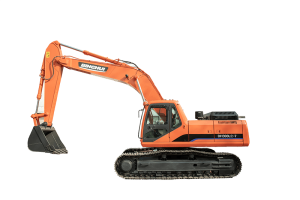An excavator is a powerful piece of heavy construction equipment primarily used for digging and earthmoving tasks. It consists of four main components: a boom, a dipper (or stick), a bucket, and a cab, all mounted on a rotating platform known as the house. This design allows the operator to perform a wide range of operations, from digging trenches and foundations to demolition and material handling.
Key Features:
- Versatility: Excavators can be equipped with various attachments, such as hydraulic breakers, grapples, and augers, enabling them to perform specialized tasks beyond simple digging.
- Mobility: Many excavators are designed to operate on tracks (crawler excavators) or wheels (wheeled excavators), allowing them to navigate different types of terrain efficiently.
- Operator Comfort: Modern excavators come with advanced controls, spacious cabs, and enhanced visibility to improve operator comfort and productivity.
Applications:
Excavators are used in various industries, including:
- Construction: For digging foundations, grading land, and trenching.
- Mining: For removing overburden and extracting minerals.
- Demolition: For breaking down structures and removing debris.
- Landscaping: For moving soil and creating features like ponds or gardens.
Types of Excavators:
- Crawler Excavators: Ideal for rough terrain and heavy lifting.
- Wheeled Excavators: Suitable for urban settings and road construction.
- Mini Excavators: Compact and maneuverable, perfect for tight spaces.
- Suction Excavators: Use vacuum technology for non-destructive digging.
Excavators play a crucial role in many construction projects, combining strength, precision, and flexibility to handle various tasks effectively.

